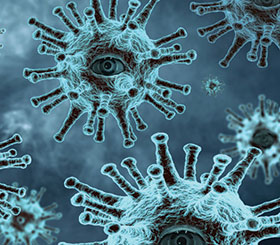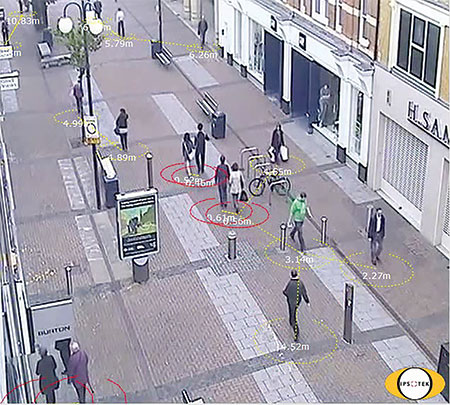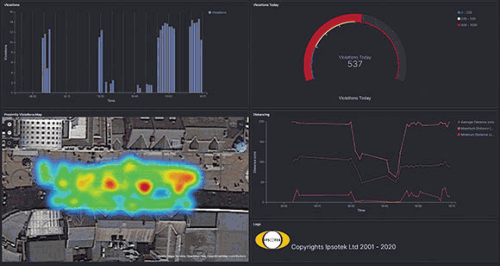

With the health sector being under great pressure in many countries, all avenues are explored in the quest to reduce the spread of the Coronavirus (COVID-19). Across the Middle East and Africa we are seeing video technology increasingly playing an important role in the fight against COVID-19. From efforts to contain the spread of the virus, to solutions that can be deployed in the protection of frontline responders in healthcare. So, what are some of the solutions that can support our health care workers in these trying times?
Reducing the spread of the virus
As the number of Coronavirus cases increases, so does the need for non-contact temperature measuring equipment. Thermal imaging cameras have for some time been adopted to support high-risk environments such as airports, train stations and immigration checkpoints. The cameras provide thermal imaging for body temperature solutions which can quickly identify people with elevated body temperatures, one of the key symptoms of COVID-19. Now these technologies are also increasingly put to use at shopping malls, medical facilities and hospitals, providing an additional layer of protection from increased exposure to the Coronavirus.
The way the thermal imaging cameras work is to instantly visualise temperature differences from a safe distance, identifying those who may have been infected. An integrated system raises an alarm when the higher temperature readings are reported and the individual can be further screened for spot testing for more accurate readings. By using the systems with thermal or infrared capabilities, health officials can quickly identify, test and if needed, isolate unwell individuals to prevent further spread of the disease.

Pros and cons of thermal cameras
The use and effectiveness of this technology has been discussed and there are indeed factors that one needs to pay attention to. First, we need to recognise that thermal body temperature solutions can only support the early identification of a key symptom of the disease, they do not diagnose COVID-19. The effectiveness of thermal imaging cameras in public areas may also be impacted by external factors like visual field and target size, environmental temperature, physical exertion etc. Privacy concern is another issue that has often been raised. This is in fact a misconception, as the thermal imaging systems are not registering any personal information on individuals.
As an alternative to measuring temperatures manually with handheld devices, which is a time consuming and labour-intensive process, thermal body temperature solutions are a non-invasive and fast method to check body temperatures from a safe distance. With the introduction of facial detection and AI, the accuracy of temperature scanning can be improved to offset environmental factors. Some thermal cameras can detect temperature differences down to 0,05 degrees and register objects and people even in total darkness at a distance of over 100 metres. The effectiveness of these cameras has led the police in Dubai to test wearing thermal imaging devices on their helmets, enabling a quick temperature scan of any individuals they encounter.
There is also the possibility of further integrating thermal body temperature solutions with video analytics for added health related functionality. This could, for example, be checking social distancing and that sanitising stations are used as specified.

Keeping a safe distance
Keeping a safe distance is a key aspect in combatting the corona virus. When the risk of contagion transmission is high, video technology has proven effective in minimising contact between infected patients and medical staff. By allowing monitoring of patients remotely medical staff can save valuable time and even help limit use of single use protective equipment. Keeping a continuous eye on all patients, video analytics notifications can be made to register incidents, for example, if a patient has had a fall or is experiencing breathing difficulties. By combining video technology with two-way audio, messages can be given to a patient from a safe distance, being it with family or nursing staff.
Video technology also helps hospitals manage public access to their facilities. In times like these, shortages of medical equipment can make hospitals more prone to thefts and access control solutions are key in securing restricted areas and preventing unauthorised access.
Drones and robots are also increasingly being used in new ways to secure safe distancing. In situations where direct contact is necessary, robots can serve as middlemen. In cases where unauthorised persons are identified, they can enable security personnel to communicate with the persons from a safe distance. In Dubai drones and robots are, for example, used to disinfect streets and buildings at night.

Staying informed and protecting personal privacy
Understanding the spread of the virus also becomes especially important, to be able to proactively plan for actions to be taken during this pandemic. From an individual level, identifying the spread of the virus by an infected person or groups of people. To societies, keeping track of the spread across the cities and countries.
Crowd management systems with the enablement of video technology can be implemented to enforce social distancing to curb down the spread of virus. Accurate counting solutions using video technology and contactless access control systems can play an important part in the areas where evacuation is required and help organisations know that no one is missed.
With video analytics and forensic tools systems can be set up to track the movements of individuals across CCTV networks. And by leveraging correlations of IoT devices, systems and intelligent analysis of large amounts of data with artificial intelligence, the spread of the virus can be tracked across societies.
In summary, innovations in video technology are proving an important ally in helping protect the health and safety of people and communities. Our video management systems provide an open platform that allow the integration of the many technologies, such as AI, analytics and heat-mapping capabilities, into video systems that play a key role in frontline containment strategies.
Granted, we need to follow the personal privacy regulations and as a video management company, we take this responsibility very seriously. To help system integrators and end users design, implement and operate GDPR-compliant video management installations, Milestone Systems provides an holistic set of tools, including an extensive GDPR Privacy Guide with ready-to-use templates, as well as privacy awareness training for end users. We work closely with our partners to navigate these unprecedented times together.
| Tel: | +27 10 500 8793 |
| Email: | [email protected] |
| www: | www.milestonesys.com |
| Articles: | More information and articles about Milestone Systems |

© Technews Publishing (Pty) Ltd. | All Rights Reserved.